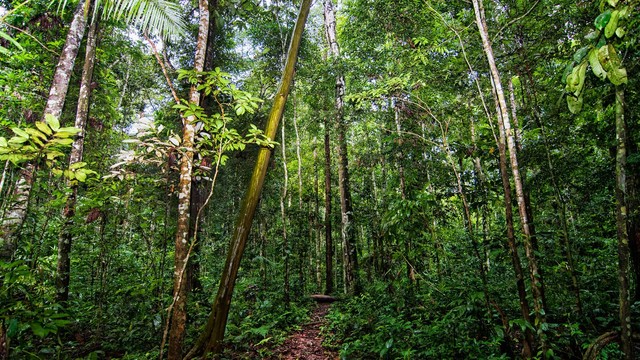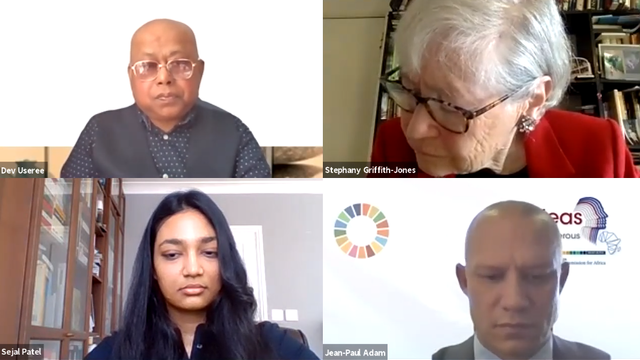Talking transdisciplinarity
Guest bloggers Alexandre Chausson and Lydia Cole discuss achieving research impact through co-producing knowledge in transdisciplinary teams.



Climate change had a devastating impact on agriculture in the Mount Kenya region, Kenya. Interdisciplinarity and transdisciplinarity work is essential to tackle complex issues (Photo: CIAT/Neil Palmer via Flickr, CC BY-SA 2.0)
How do we really achieve impact in our work? The societal challenges of the 21st century – notably climate change, biodiversity loss and global inequality – are interlinked and cross-cutting, hence they cannot be resolved through siloed or sectoral approaches.
They call on researchers to work across disciplines, and to actively engage and work collaboratively with research users, including local communities, practitioners, businesses and policymakers to produce actionable research. Yet the need for truly collaborative problem solving is often underappreciated in the environmental conservation sector.
Perspectives, goals and priorities between researchers and research users often differ. Therefore, the answer to the critical question on how to achieve impact continues to evade us.
The IIED-led SENTINEL project and the British Ecological Society’s Conservation Ecology Group co-ran an online workshop at the 2020 Festival of Ecology. The workshop’s aim was to unpack transdisciplinary working and explore the facets of collaborative knowledge production that lie at its core.
Over 50 participants joined – primarily academics but also representatives from civil society, industry and government. Our objective was to increase awareness of what transdisciplinary working entails, and the competencies, tools and techniques required for fostering collaboration between researchers and research users.
We were joined by three experienced researchers and practitioners: researcher Abbie Chapman, communications expert Clair Grant-Salmon (IIED's head of audience development ) and research user Steve Gibson. They shared their experiences of working with people from a variety of disciplines on projects that apply research to address practical environmental challenges.
Here we summarise key themes and lessons explored in the workshop and drawn from the SENTINEL project.
Defining transdisciplinarity
Shared language and understanding are the foundations for achieving project impact; defining key terms and building a shared conceptual framework of the project is crucial. The workshop defined multidisciplinary, interdisciplinary and transdisciplinary working – these are often used interchangeably yet each approaches knowledge production differently.

The principles of collaboration behind multidisciplinary, interdisciplinary and transdisciplinary working (left to right, respectively) (Photo: Sentinel)
- Multidisciplinarity: different disciplines (the square facets above left) work in parallel, with little or no integration of ideas, methods or outputs
- Interdisciplinarity: crossing disciplinary boundaries to create new knowledge, theory, or methodologies and,
- Transdisciplinarity: integrating different knowledge systems (the interwoven coloured strings), or ways of knowing, beyond academia, such as practitioner knowledge, or local and indigenous knowledge.
Therefore, while many competencies, tools and techniques for interdisciplinary working apply to transdisciplinary working, the latter requires additional skills and abilities of research teams to co-produce and implement knowledge.
The right approach to take depends on the scope of study, the make-up of project partners and the project’s ambitions. Interdisciplinarity and transdisciplinarity are not necessarily ‘better’ than disciplinary research: disciplinary research is crucial for expanding knowledge frontiers into specific research topics.
However, if the main objective is knowledge integration across disciplines, or achieving societal impact such as influencing a country’s policies, then inter- and transdisciplinary ways of working are essential.
Communication is key
To gauge how the audience perceived transdisciplinarity, and how this changed over the course of the workshop, we asked each participant to submit two words representing transdisciplinarity to a Mentimeter survey, both at the start and end of the workshop.

At the start of the workshop, participants were asked to submit two words they associate with transdisciplinary working (Image: Sentinel)
The results show a clear shift from collaboration to communication. Communication is crucial for enabling effective teamwork and engaging research users, regardless of the project’s focus. In transdisciplinary and interdisciplinary projects, effective communication supports a shared understanding of partners’ perspectives, objectives and challenges.
It also ensures the flow of information to support research conceptualisation, method design, research implementation and synthesis.
Achieving impact also calls for tailored, adaptable communication strategies to engage potential research users who may not be embedded in research teams. The strategy should identify the target research users, their relationships, what messages will get the most traction and through which channels.

By the end of the workshop, participants had shifted from ‘collaboration’ to ‘communication’ (Image: Sentinel)
Seven steps towards effective transdisciplinary working
Ninety minutes was not sufficient to explore the full breadth and depth of transdisciplinarity working. However, the panel discussion identified seven ‘top tips’ to guide researchers through effective transdisciplinary projects:
- Understand your team members: 1) their disciplinary or professional background; 2) their perspective and priorities; and, 3) the contextual realities they work in, including constraints
- Foster confidence, trust and supportive dialogues, enabling team members to share and discuss perspectives, ideas, methods or results, and develop a shared understanding and project vision
- Be prepared to spend time developing project goals and objectives at the start, explicitly discussing and encompassing what could be a range of different priorities between different stakeholders
- Discuss project outputs and expectations as close to the project start as possible, bearing in mind potential conflicting workloads and career requirements
- Put a communication strategy in place from the start – it can be revised throughout the project. The strategy should include processes to identify, understand and engage with stakeholders throughout the course of a project
- Establish effective leadership, that equitably engages the diversity of team members to foster a collaborative working environment, and
- Incorporate ample time and contingency to foster dialogue, negotiation and joint iterative reflection to learn, and adaptively manage the project.




